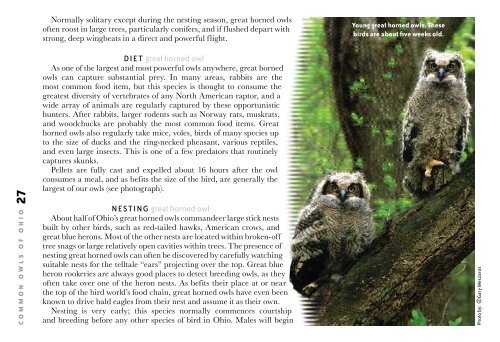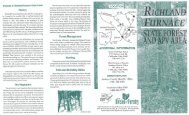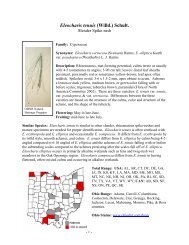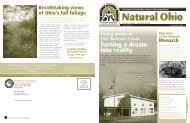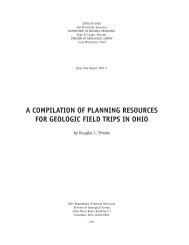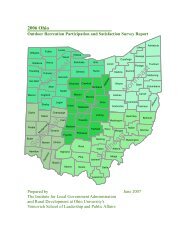Owls of Ohio - Ohio Department of Natural Resources
Owls of Ohio - Ohio Department of Natural Resources
Owls of Ohio - Ohio Department of Natural Resources
You also want an ePaper? Increase the reach of your titles
YUMPU automatically turns print PDFs into web optimized ePapers that Google loves.
Normally solitary except during the nesting season, great horned owls<strong>of</strong>ten roost in large trees, particularly conifers, and if flushed depart withstrong, deep wingbeats in a direct and powerful flight.Young great horned owls. Thesebirds are about five weeks old.C O M M O N O W L S O F O H I O 27D i e t great horned owlAs one <strong>of</strong> the largest and most powerful owls anywhere, great hornedowls can capture substantial prey. In many areas, rabbits are themost common food item, but this species is thought to consume thegreatest diversity <strong>of</strong> vertebrates <strong>of</strong> any North American raptor, and awide array <strong>of</strong> animals are regularly captured by these opportunistichunters. After rabbits, larger rodents such as Norway rats, muskrats,and woodchucks are probably the most common food items. Greathorned owls also regularly take mice, voles, birds <strong>of</strong> many species upto the size <strong>of</strong> ducks and the ring-necked pheasant, various reptiles,and even large insects. This is one <strong>of</strong> a few predators that routinelycaptures skunks.Pellets are fully cast and expelled about 16 hours after the owlconsumes a meal, and as befits the size <strong>of</strong> the bird, are generally thelargest <strong>of</strong> our owls (see photograph).N e s ting great horned owlAbout half <strong>of</strong> <strong>Ohio</strong>’s great horned owls commandeer large stick nestsbuilt by other birds, such as red-tailed hawks, American crows, andgreat blue herons. Most <strong>of</strong> the other nests are located within broken-<strong>of</strong>ftree snags or large relatively open cavities within trees. The presence <strong>of</strong>nesting great horned owls can <strong>of</strong>ten be discovered by carefully watchingsuitable nests for the telltale “ears” projecting over the top. Great blueheron rookeries are always good places to detect breeding owls, as they<strong>of</strong>ten take over one <strong>of</strong> the heron nests. As befits their place at or nearthe top <strong>of</strong> the bird world’s food chain, great horned owls have even beenknown to drive bald eagles from their nest and assume it as their own.Nesting is very early; this species normally commences courtshipand breeding before any other species <strong>of</strong> bird in <strong>Ohio</strong>. Males will beginPhoto by: ©Gary Meszaros


